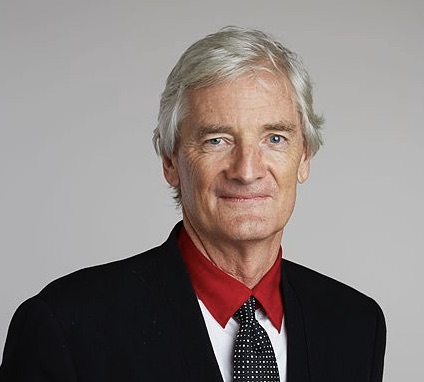
James Dyson was born on May 2, 1947 in Cromer, Norfolk, UK. Between ages 9 to 18 he attended Gresham’s School, a private boarding school in Norfolk. When his father died of prostate cancer in 1965, James embarked on a career in art, studying furniture and interior design at the Royal College of Art between 1966 and 1970. During his final year of studies at the Royal College, James worked with Jeremy Fry in the design of the Rotork Sea Truck, a flat fiberglass craft that could deliver cargo to shores where there were no harbors.
Emboldened by the success of this joint venture, James founded his own company in 1974 and launched his first original invention–the ball barrow. This was a modification of the wheelbarrow in which the wheel was replaced by a spherical ball, enabling it to move in any direction. Dyson’s “reinvention of the wheel” was manifest in a variety of subsequent inventions including the Trolleyball and the Wheelboat.
Soon after James Dyson reached his early 30’s his attention turned toward the inefficient Hoover vacuum cleaner that lost suction as the dust bags filled with debris. Applying the principle of centrifugal force that nuclear physicists use to separate different isotopes of uranium, he developed a vacuum cleaner that rotated the heavier dust particles, spiralling downward and out of the suction part of the canister. Developing the ultimate cyclonic separation vacuum involved the development of more than 5000 prototypes and a Herculean resolve, that Dyson later attributed to the persistence he learned during his school participation in long-distance races.
Since the market for replacement dust bags was lucrative and the G-force cleaner was dust-bag free, Dyson could not find anyone in the UK who would manufacture or distribute his new invention, so he had been forced to develop and manufacture the prototypes through his company, Dyson Ltd. In 1983, after five years of research supported by his wife’s salary as an art teacher, James Dyson launched his answer to the vacuum cleaner–the G-force cleaner. Seeking an alternative market for his invention, he used catalogs to promote his invention in Japan, selling it for just over $5000 (in today’s dollars). In 1991, Dyson’s G-force cleaner won the International Design Fair Prize in Japan.
Using the slogan, “say goodbye to the bag”, Dyson’s G-force cleaner that had metamorphosed into The Dyson Dual Cyclone became the fastest-selling vacuum cleaner in the UK and by 2005 had generated more revenue than any competitor in the US. In 1999, Dyson successfully sued Hoover (UK) for patent infringement when they attempted to copy his design.
As Dyson Ltd. entered the 21st century, it continued to offer new inventions including a washing machine and the ubiquitous air-driven hand-dryers that we see in public washrooms. In the second decade of this century, Dyson is reported to spending more than £7 million a week on research and development in AI and robotics.
During the past several decades, Dyson has received a variety of awards and honorary doctorates for his creativity and insights. In 2007 James Dyson was appointed Knight Bachelor and became “Sir James Dyson.” Later that year, during an interview with Fast Company Magazine, Sir James stated:
I made 5,127 prototypes of my vacuum before I got it right. There were 5,126 failures. But I learned from each one. That’s how I came up with a solution. So I don’t mind failure. I’ve always thought that schoolchildren should be marked by the number of failures they’ve had. The child who tries strange things and experiences lots of failures to get there is probably more creative.
